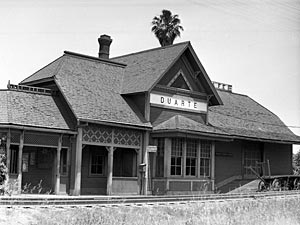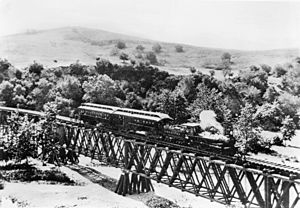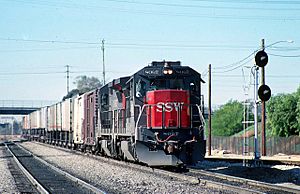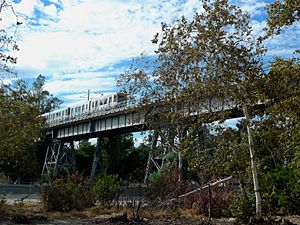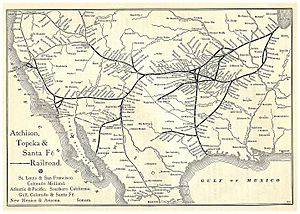California Central Railway facts for kids
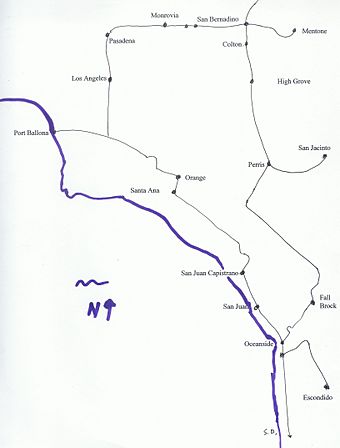
Map of California Central Railway lines in 1889
|
|
| Overview | |
|---|---|
| Headquarters | San Bernardino, California |
| Locale | Southern California |
| Dates of operation | April 23, 1887–November 7, 1889 |
| Successor | Atchison, Topeka and Santa Fe Railway |
| Technical | |
| Track gauge | 4 ft 8 1⁄2 in (1,435 mm) standard gauge |
| Length | 250 miles (400 km) |
The California Central Railway was a railroad company in Southern California. It was started on April 23, 1887. Its main office was in San Bernardino, California. George O. Manchester was the company's president.
At its busiest, the railway ran about 400 kilometers (250 miles) of track. It had 14 steam locomotives, 14 passenger cars, and 83 freight cars. The California Central Railway operated from May 20, 1887, until November 7, 1889. By the end of 1888, the company was worth over $12 million.
On November 7, 1889, the California Central Railway joined with two other companies. These were the California Southern Railroad and the Redondo Beach Railway. Together, they formed a new company called the Southern California Railway Company. Before this, the California Central Railway had already become a part of the Atchison, Topeka and Santa Fe Railway system in 1888.
Contents
California Central Railway: Early Lines
The California Central Railway had important main lines. These connected San Bernardino to Los Angeles at La Grande Station. Another line went from Oceanside to Los Angeles. There was also a line from High Grove to Orange.
The railway also operated a 30-kilometer (19-mile) line in Riverside County. This line ran between Perris and San Jacinto. It was in use from May 1887 to May 1888.
In September 1887, the California Central Railway opened a 21-kilometer (13-mile) line. This line went from Port Ballona (now Playa del Rey, Los Angeles) to Redondo Junction. Redondo Junction became a key place for train repairs.
California Central Railway: Growing the Network
The California Central Railway grew by building new lines and taking over smaller railway companies. This helped them connect more cities in Southern California.
Redondo Beach Railway
The Redondo Beach Railway started in April 1888. It began selling bonds to raise money in June 1888. Henry E. Huntington, a famous businessman, owned much of this railway. The line started running on September 1, 1888.
The California Central Railway operated the 18-kilometer (11-mile) Redondo Beach Railway line. This line went from Redondo Beach to Inglewood, California. It also stopped at Burwell and Port Ballona. The first train ran on April 16, 1888. From Inglewood, the line continued to downtown Los Angeles using California Central Railway tracks.
The Redondo Beach Railway helped make Redondo a popular spot for tourists. This was especially true after the Hotel Redondo opened in 1890. The Redondo Beach Railway company joined the Southern California Railway on November 7, 1889. Later, when streetcar lines opened in 1902, fewer people rode the Redondo Beach Railway trains.
Riverside, Santa Ana and Los Angeles Railway
The California Central Railway finished building lines started by the Riverside, Santa Ana and Los Angeles Railway.
- A 55-kilometer (34-mile) line from Santa Ana to Los Angeles was completed on August 12, 1888.
- A 66-kilometer (41-mile) line from High Grove to Orange was finished on September 15, 1887.
San Bernardino and San Diego Railway
The California Central Railway also completed lines started by the San Bernardino and San Diego Railway. This brought train service to San Diego County.
- A 56-kilometer (35-mile) line from Santa Ana to San Juan (now San Clemente) was finished on November 30, 1887.
- A 24-kilometer (15-mile) line from San Juan to Fallbrook Junction was completed on August 12, 1888.
A Victorian-style train station was built in 1887 at the site of today's San Diego Union Station. Today, the Pacific Surfliner train still uses parts of this historic line.
San Bernardino & Los Angeles Railway
The California Central Railway finished a line started by the San Bernardino & Los Angeles Railway Co. This 61-kilometer (38-mile) line from San Bernardino to Duarte was completed on May 31, 1887. This line connected with the Los Angeles and San Gabriel Valley Railroad at Duarte.
Other stations on this line included Claremont and North Pomona. Some towns like Rialto and North Ontario started as train stops along this route. This line later became part of the Santa Fe Southwest Chief route until 1994.
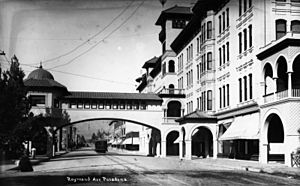
Los Angeles and San Gabriel Valley Railroad
The Los Angeles and San Gabriel Valley Railroad was started in 1883. On September 16, 1885, a big celebration was held in Pasadena. This was for the completion of the line from downtown Los Angeles to Lamanda Park in East Pasadena.
This railway line went through the Arroyo Seco to Pasadena. It crossed the Arroyo Seco near Garvanza in Highland Park.
The California Central Railway bought the Los Angeles and San Gabriel Valley Railroad on May 20, 1887. They connected it to the Duarte line. This created a complete railway line from San Bernardino to Downtown Los Angeles. This new line served stations in Azusa, Monrovia, Pasadena, and Rancho Santa Anita.
San Bernardino Valley Railway
The California Central Railway completed a line started by the San Bernardino Valley Railway Co. This 21-kilometer (13-mile) line went from San Bernardino to Mentone, California. It was finished on December 31, 1887. The original plan was to build to Lugonia (now Redlands).
San Diego Central Railroad
The California Central Railway also finished a 34-kilometer (21-mile) line in San Diego County. This line was started by the San Diego Central Railroad Co. It ran from Escondido Junction (south of Oceanside) to Escondido. Service began in 1887. The San Diego Central Railroad only built the line between Escondido and Oceanside.
Los Angeles and Santa Monica Railroad
The Los Angeles and Santa Monica Railroad was formed in 1886. Its goal was to build a line from downtown Los Angeles to Santa Monica Bay. The California Central Railway bought this company. While no tracks were built yet, California Central Railway gained important land for the railway.
This 29-kilometer (18.03-mile) line opened on September 7, 1887. It had stops at places like Ballona Junction, Inglewood, and Port Ballona. A train would leave Los Angeles at 9:15 a.m. and take about an hour to reach Port Ballona.
San Jacinto Railway
The San Jacinto Railway was started in 1887 in Riverside County. The California Central Railway bought this company. Although no tracks were built yet, California Central Railway got the needed land.
Construction began in 1887. This branch line ran from Perris to San Jacinto. It started operating on May 20, 1888. The first train arrived in Winchester.
The Santa Fe Connection
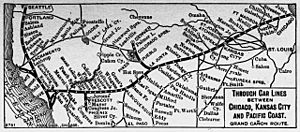
Important railway leaders like Jay Gould and Collis Potter Huntington tried to keep the Santa Fe Railway out of Los Angeles. However, in May 1887, the first Santa Fe train arrived in Los Angeles. Santa Fe had a costly agreement to use Southern Pacific Railway tracks from Colton to Los Angeles for about 18 months.
When the California Central Railway bought the Los Angeles and San Gabriel Valley Railroad in May 1887, it was a big step. The California Central Railway was a part of the Santa Fe system. This purchase connected the two lines at Mud Springs. This completed a railway line all the way from Chicago to Los Angeles through the San Gabriel Valley. The Santa Fe line served the San Gabriel Valley until 1994. The 1994 Northridge earthquake damaged a bridge in Arcadia, which led to the line's closure.
Modern Use: Los Angeles Metro Rail
The old railway path, or right of way, of the Los Angeles and San Gabriel Valley Railroad is now used again. It is part of the Los Angeles Metro light rail system. In the late 1990s, construction began for the Gold Line on this path. The Gold Line opened in 2003.
In 2013, more construction started further east for the Gold Line Foothill Extension. This extension goes through the San Gabriel Valley and Pomona Valley to Azusa. It uses the historic 1926 Monrovia Santa Fe Depot as its Monrovia Metro Station. The site of the Azusa Depot is now the Azusa Metro Station.
The End of California Central Railway
The California Southern Railroad joined the California Central Railway Company in June 1887. Later, a big economic downturn happened, which was called the "great land boom collapse." Because of this, the California Southern Railroad, the California Central Railway, and the Redondo Beach Railway all merged in 1889. The new company was named the Southern California Railway Company. All the train repair shops were moved to San Bernardino, and the main railway office moved to Los Angeles.
Images for kids
-
Pasadena Hotel Green, with bridge to the Pasadena rail station.
-
1890, An AT&SF passenger train in operation, c. 1895.
-
map of the Atchison, Topeka and Santa Fe Railway c. 1901



